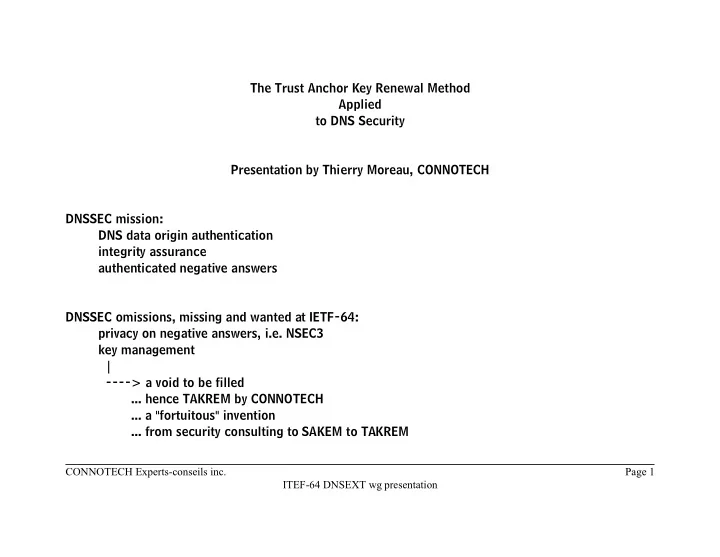

The Trust Anchor Key Renewal Method Applied to DNS Security Presentation by Thierry Moreau, CONNOTECH DNSSEC mission: DNS data origin authentication integrity assurance authenticated negative answers DNSSEC omissions, missing and wanted at IETF-64: privacy on negative answers, i.e. NSEC3 key management | ----> a void to be filled ... hence TAKREM by CONNOTECH ... a "fortuitous" invention ... from security consulting to SAKEM to TAKREM CONNOTECH Experts-conseils inc. Page 1 ITEF-64 DNSEXT wg presentation
Trust Anchor Key Rollover Hard Technology Requirements � DNS resolver automation � Golden rule: security automation => cryptography assisted solution why roll anchor keys in the first place? o cryptographic strength concerns, o security operations concerns, o survivability concerns: a scheduled rollover is a rehearsal for an emergency rollover, an alternative for it. any scheme has a "catastrophic failure mode" i.e. when the rollover crypto breaks signature chaining over time ... fails on ... a private key compromise (weak link) long-lasting master key ... fails on ... a master key compromise pre-announced fingerprints of keys ... fails on ... key compromise in dormant state CONNOTECH Experts-conseils inc. Page 2 ITEF-64 DNSEXT wg presentation
Trust Anchor Key Rollover Soft Technology Requirements operational: rollover tied to zone manager procedures resolver programs are user agents, no "MUST" for end-users � specify zone manager procedures � � that enable resolvers to roll KSK with on-going trust � "the DNS devil is in the details" deployment requirements root ultimately, rollover required only for the root put something trusted in ISC bind release before live deployment other "islands of trust" large number of islands of trust transition from island of trust to normal signed zone (no going back to unsigned parent) CONNOTECH Experts-conseils inc. Page 3 ITEF-64 DNSEXT wg presentation
TAKREM in DNS -- Rollover Procedure zone manager rollover preparation retrieves a future trust anchor key from dead storage, publishes new DNSKEY (SEP=1) RR, gets the parent to sign the DS RR, and/or publishes SDDA RR for the new KSK uses the new DNSKEY (SEP=1) RR to sign DNSKEY RRset resolver state before rollover, integrity protected configuration: trusted digests for future trust anchor keys current trust anchor key resolver procedure encounters an unknown DNSKEY (SEP=1) RR checks parental DS RR (up to a trust anchor) if trusted digests are configured for the zone - and - no validated parental DS RR then queries the zone SDDA RRset validates DNSKEY + SDDA against trusted digests if validated, accepts DNSKEY RR as new current T.A.K. TAKREM validation failure: ignore the DNSKEY RR as a new current trust anchor key flag the current DNS request as bogus CONNOTECH Experts-conseils inc. Page 4 ITEF-64 DNSEXT wg presentation
TAKREM in DNS Solution Properties zone management procedures simple zone management procedures manifest procedures for the auditor function "who guards the guards" emergency rollover same as scheduled rollover (except for the key revocation issue) DNS protocol properties single DNSKEY (SEP=1) RR no need for resolvers to stay on-line as with chained rollovers smooth transition from island of security to normal zone uses simple DNS lookup for the SDDA RRset CONNOTECH Experts-conseils inc. Page 5 ITEF-64 DNSEXT wg presentation
Next Steps TAKREM for DNSSEC available as an IETF DNSEXT contribution: change control handed over to IETF best alternative to long-lasting trust anchor key commitment to bring T.A.K. rollover in DNSEXT scope going past the "get it done anyhow" attitude define overall requirements, given "catastrophic failure mode" detailed requirements definition is anything mandatory beyond root zone management procedures? resolver requirements --> user interface for indeterminate DNS results TAKREM tames the "resolver trust anchor pop-up paradox" CONNOTECH Experts-conseils inc. Page 6 ITEF-64 DNSEXT wg presentation
the end CONNOTECH Experts-conseils inc. Page 7 ITEF-64 DNSEXT wg presentation
Appendix -- Cryptographic Principles context of crypto usage very infrequent use don't automate infrequent/low volume operations handling keys on the server side ---> manual procedures fully automated on resolver side intended to support long-term trust in resolvers ---> larger crypto parameter sizes TAKREM uses a "pre-announced fingerprint" approach long-term resistance to cryptanalysis: hidden hash primitive selection (from a function family) variable cryptographic strength MASH Modular Arithmetic Secure Hash based on the Rabin-Williams one-way trapdoor function (other being RSA variant, discrete log and elliptic curve) i.e. best number-theoretic support ([Boneh, Bernstein, ...]) an ISO/IEC standard, development process supported by academia modulus selection like Rabin-Williams or RSA too slow for anything but infrequent use (consistent with avoiding e.g. SHA-1 collapse threat) CONNOTECH Experts-conseils inc. Page 8 ITEF-64 DNSEXT wg presentation
Recommend
More recommend